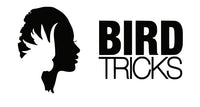
We met this really great woman at one of our shows who took to our parrot, Bondi, straight away and of course Bondi took to her just as fast. She told us about the Free Again Wildlife Rehab center her friend runs and invited us out the next morning. We were really excited about it, and jumped on the opportunity for a tour. There were no parrots here, but Beth (the owner) basically takes on any injured wild animals and rehabilitates them so they can be re-released into the wild. She releases them as far away as possible from her facility that they are healed at. Her biggest success rate is with squirrels, and her lowest success rate is with the very fragile bunnies.

Photo by Dave Womach Location: Free Again Wildlife Rehab Center
We got to see her and another lady feeding baby raccoons and opossums, and we got to see tons of predatory birds up close and personally which was just amazing. Learning more about the birds you have to worry about getting your own birds is very interesting and you can never know too much. Seeing the size of the bald eagles they had up close and personally just blew my mind. I always forget how massive they are compared to our companion parrots. Most of the cages were empty which was a great sign and means she had recently been able to release almost all the animals she had taken in. There were no deer to see, and only two goats and two vultures. The owls were probably my favorites. Adorable, and those eyes...

Photo by Dave Womach Location: Free Again Wildlife Rehab Center
We went into the sick room which was insanely sad. One small owl whom I thought was looking to the side, was actually infected with the west nile virus and its head was permanently sideways because of it. I couldn't imagine the awkwardness and constant pain that bird is living with, that's can't possibly be comfortable. Birds like that one will probably not be able to make it in the wild. Some are too sick to be rehabilitated, others have injuries that can heal and in time they can go back to their wild nature.
Most birds came in with wing injuries and if already healed, they were healed wrong making the bird unable to fly, or to fly awkwardly but not well enough to hunt. These had to be managed very carefully as the wings are so fragile and the bones thin.

Photo by Dave Womach Location: Free Again Wildlife Rehab Center
The enclosures were large enough for these birds to be flying around in and working on their skills. Most were housed together with at least one other bird of the same species. Hawks were together and bickering which made it so they flew and got around even more. We even witnessed some owls that were ready for release any day.
Dave was brave enough to go inside many of the flights to obtain these pictures. I stayed on the other side...
This hawk had one wing that was severely injured. He kept trying to fly up to where the other hawks were, but couldn't make it with only one working wing, however he never stopped trying except to rest. With that passion, he can work through his injury. Others that were fighting were ready for release once they had mastered their hunting skills. At the rehab center they start with dead mice and things for them to eat, then begin feeding them live ones in large tires so that they can see how their hunting skills are progressing and determine how soon they're ready for release. They must be able to hunt on their own and feed themselves or they'll never make it.

Photo by Dave Womach Location: Free Again Wildlife Rehab Center
I really liked that on our tour, and especially when it came to the sick birds, we were told to approach very slowly, calmly and keep quiet. We didn't want to overstimulate and we didn't want to scare any of the birds. They were all wild, and they needed to stay that way in order to go back into the wild someday. They couldn't realize that humans = a source of food, otherwise they won't make it. That, I think, is one of the hardest aspects of Free Again. When they get baby animals they are so cute and cuddly, and you just want to pamper them and take care of them but if you over-do it, they become tame.
There was a breath of relief everytime we approached an enclosure and the animals didn't come out of their hiding, or flew away. It meant they were hanging on to their wild nature and would have a better chance out there. If they came over willingly, they knew they needed more distance from humans and less hands on with food or water. Many times food and water couldn't be given without being seen and this made things hard between human and animal.
It would be so hard to resist pampering a baby animal in need knowing that it's for the betterment of the animal that you just don't. They're doing a great thing at Free Again. You can find them on facebook if you'd like to learn more, schedule your own tour or donate to the cause as they exist purely off donations and free help in building enclosures or donating supplies (wood, tools for more enclosures, feed, etc)
Article by Jamieleigh Womach. She has been working with parrots and toucans since the age of 17. She isn’t homeless but is home less than she prefers to be. She travels the world with her husband, daughter, and a flockful of parrots whom she shares the stage with.


Be the first to comment